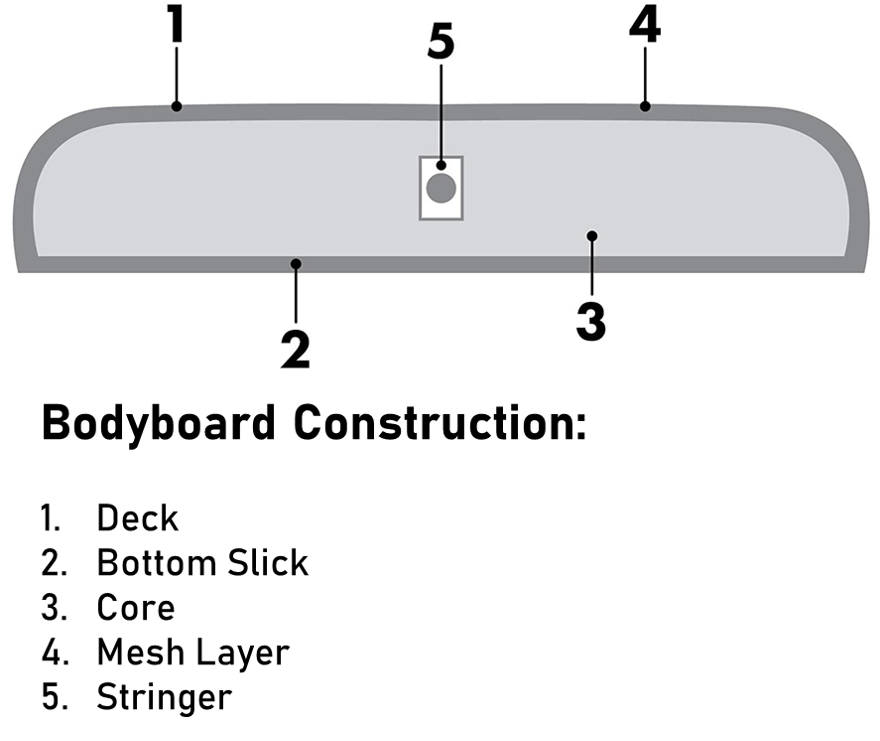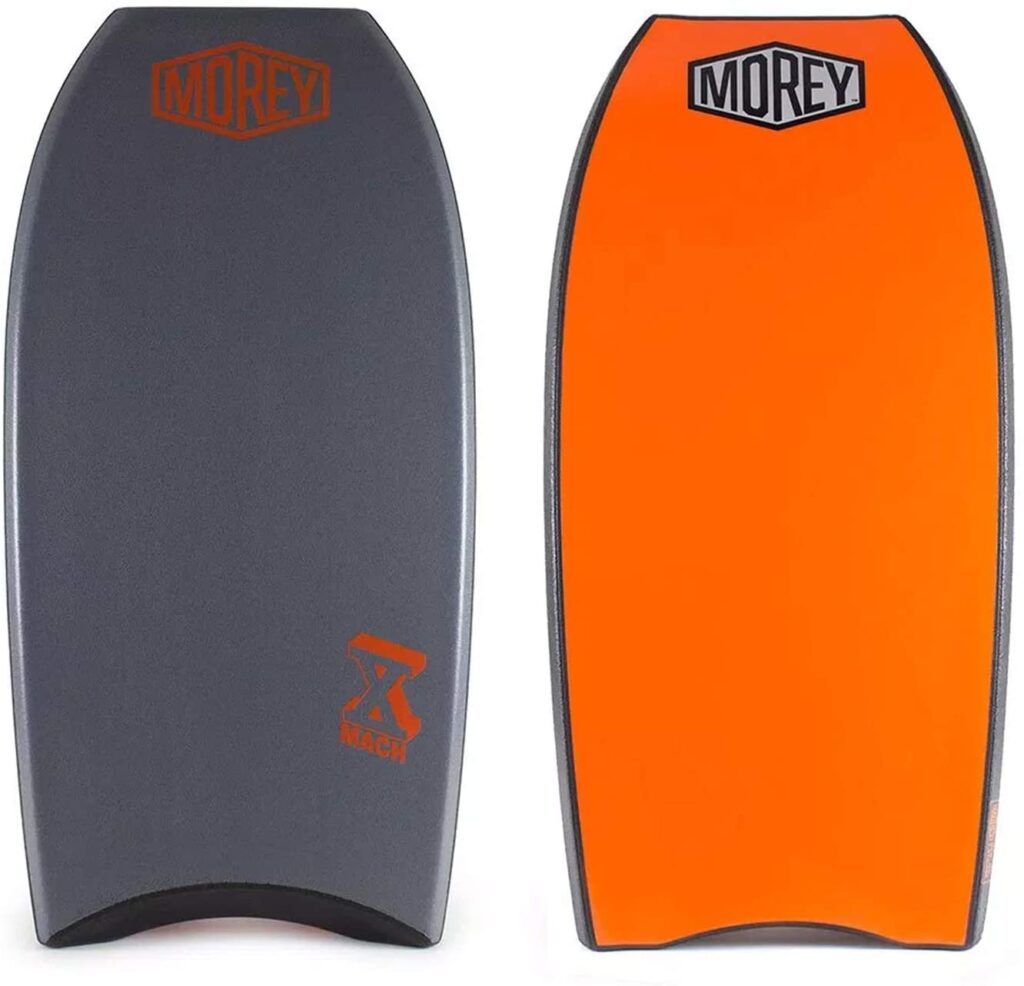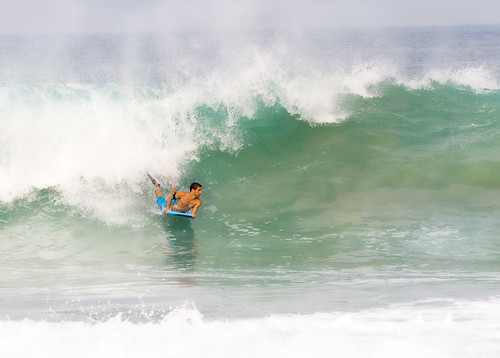Bodyboards come in a variety of designs but can also consist of various materials. Though they might look the same, two bodyboards can feel and act differently in the water. It’s all thanks to bodyboard materials and their construction, so here’s a quick rundown of the most commonly encountered ones.
In this article you learn about the most important types of bodyboards, the materials used to produce these and the pros and cons of each.
If you need more information about how to choose your personal best fit Bodyboard including size chart and more, just have a look here.

Different Types of bodyboards: Why Do Bodyboard Materials actually matter?
You can bodyboard on any material – once. Your homemade bodyboard is likely to feel awkward, generate a lot of drag and crumble in the slightest ripple. If you want to improve your bodyboarding skills, you need a consistent experience that can only come through using a professionally made bodyboard.
All professionally produced bodyboards have to be engineered to perform in a certain way in water, namely, they have to:
- give you enough speed
- let you control your direction somewhat
- endure some stresses and impacts
- provide enough comfort
There is no best bodyboard material that can provide excellent performance in all four aspects at all times; engineering is always about finding the least painful compromise.
So, don’t waste your time looking for the perfect bodyboard but focus on the aspect you want the most and then build your bodyboard set around it.
Professional riders have a set of bodyboards so they can pick the one that suits their mood, climate, water temperature, surf intensity and so on. They also know the limits of each material and can sense when the bodyboard is about to give. For beginners, it’s more about finding a budget – friendly bodyboard that is overall acceptable in all four aspects.
Bodyboard construction: What are the different parts of a Bodyboard?
Bodyboard Construction
Once you understand the performance of a material, bodyboards are easy to grasp.

However, different parts of the bodyboard have a distinct impact on the riding experience and are thus made out of various materials.
For example, you can find different:
- bodyboard core materials
- bodyboard deck materials
- bodyboard slick materials
- bodyboard with or without stringers and mesh layer
In our experience, mainly the core materials and stringers have the biggest effect of how a board feeld during surfing, whereas the mesh layer and the stringers have a huge impact on the robustness and durability of your board.
The most important features of a Bodyboard
Besides the Bodyboard More Material and the construction of a Bodyboard there are some important features of a Bodyboard, especially regarding its shape:
- The size of the Bodyboard
- Thickness and Width
- Stringers
- The Tail and the Nose
- and some more
We don’t go into the details here. If you want to have more information about the important features of a bodyboard (like the Rail-Ratio or the Wide Point) and why they are important when picking one, you should have a look at our Buyer’s Guide which also includes a size and weight chart.
Different Types of Bodyboards: what they are and for whom they fit best
Generally there are two types of Bodyboard:
- Inflatable Bodyboard
- Hardboard
In the following section we show you the advantages and disadvantages as well the differences of Bodyboards made out of different materials. In the end you will know, which Type of Bodyboard is suited for which type of rider. This will allow you to make a more informed decision when choosing your own Bodyboard.
Inflatable Bodyboard (Material: Vinyl)

Inflatable bodyboards are most often made out of vinyl, giving them excellent buoyancy at the expense of having to inflate and deflate them.
The comfort is superb on a vinyl bodyboard, though the durability is lacking.
Any kind of grit launched at this bodyboard can torpedo it in an instant but handles can also easily get ripped off by accident.
This type of bodyboard is for primarily for kids starting out and absolute newbie riders who want to just have some fun in the waves. Choose calm waters and controllable environments and remember that these boards will not very long.
One prime example is JOYIN Inflatable Boogie Boards for Kids.
Wooden Bodyboard (Material: Wood)
This kind of bodyboard is not made out of solid wood but rather plywood or laminated wood.
It is actually one of superior bodyboard materials, thanks to the natural buoyancy, bendiness and cheapness of wood, though you’d be hard – pressed to find one on the market.
Bodyboard riders who are really into the thrill of chasing waves make their own wooden bodyboards by simply planing and sanding the plywood.
The performance of a wooden bodyboard all comes down to the smoothness of its surface. If there are any nicks or bumps on its surface, the wooden bodyboard will behave unpredictably in the water.
PP Bodyboard (Material: Polypropylene Foam)

This material has a good memory and easily returns to its original shape. Its main advantages are low weight and decent stiffness, giving PP boards solid overall performance and a very good performance in colder weather.
PP boards are the best allround Bodyboard concerning water temperatures.
Nowadays all PP Boards have at least one stringer and / or mesh layer in them: PP core Boards should be you choice if you want to have a performant all – year board which you can use in all conditions.
To be honest with you, PP boards are typically the most expensive ones. But you get superior quality in exchange… A good example of a great PP Board with a good price – performance ratio is the Morey Mach 10.
PE Bodyboard (Material: Dow Polyethylene Foam)

PE Bodyboards are about double the prize compared to the entry – level EPS core boards but are cheaper than the PP Core boards.
But there is a reason why PE is used for decades in bodyboards: PE provides the durability and buoyancy needed.
Compared to a PP core Board, PE boards are a little heavier and less suitable for warm waters above 75°F, because PE then looses more stiffness (and the risk that you buckle your board increases).
Nowadays most of the PE boards also have so – called stringers and some have a mesh in them which prevents them from flexing too much.
Consequently, choosing a PE board is definitely a good choice except you mostly surf in tropical waters as they give you a really good price – performance ratio.
The Morey Mach 7 is a good example of such a PE Core Bodyboard, which has a really good price – performance ratio and is therefore a good choice for beginners as well as advanced riders.
EPS Bodyboard (Material: Extruded Polystyrene)
Polystyrene bodyboards were popular during the 1980s, when bodyboarding experienced its first wave of popularity.

You could buy them in supermarkets, which meant a cheap price, poor performance and low durability. They were disposable bodyboards intended for tourists and total newbie riders.
Today, we have an upgrade on the polystyrene formula, the EPS. It’s not much better than the polystyrene bodyboards of yore, but it is soft and suitable for people who want to know what bodyboarding feels like without paying an arm and a leg for a quality bodyboard.
You can also find bodyboards made out of arcel, which is a composite material that comprises 70% EPS and 30% PE. It is one step up from EPS, especially with regards to its durability. Another improvement regarding overall Quality provide EPS Core Boards which have a stringer included.
Pure EPS Bodyboards are still by far the cheapest you can find, but they are neither durable nor suitable for more than just surfing some small waves. EPS Boards with a Stringer are a further upgrade and are still affordable.
So if you look just for a water toy or just a cheap solution to test if bodyboarding is something for you, pure EPS boards are allright. But as soon as you want to ride regularly some waves, it’s worth to spend a little more on a better quality Bodyboard. So we suggest that you look for a board which does have at least one stringer and, ideally, a mesh layer integrated.
A good EPS Core Bodyboard, which has a single stringer for more stiffness and durability, would be the Kona Surf Turbo.
However, you have to be aware that such a quality EPS Board is that not much cheaper anymore than a Board with a PE Core like the Morey Mach 7.
Final Thoughts on the different types of bodyboards and on bodyboard core types
Bodyboard manufacturers have a pretty good idea of what makes a fine bodyboard, so you’ll most often see the same formula across brands – composite materials sandwiched together. That creates a sturdy yet flexible bodyboard that is light and can withstand a lot of punishment.
Still, don’t expect your bodyboard to last you more than several years. When exposed to water, salt, mechanical stresses and UV rays, all materials have to buckle to an extent, especially the composite ones, which also tend to peel off.
If you want our recommendation for the best overall bodyboard for beginners, check out the Kona Surf Turbo or Morey Mach 7.
The Kona Surf Turbo is an EPS Core Board but has a single wooden stringer system, which gives it good stiffness and also superior durability compared to other EPC Core Bodyboards.
A slightly higher quality Bodyboard, but still a good deal when beginning, would be the Morey Mach 7, a PE Core and single Stringer Board, which will be companion from the beginnings until your first bigger waves.
The secret to becoming a skilled rider is trying out all kinds of bodyboards to get a feel for their behavior in and out of the water. And therewith find your personal preferences. When you do find a bodyboard you like and that provides fine performance, immediately buy several. This is because bodyboard manufacturers discontinue bodyboards, making it impossible to find a replacement a few years down the line.
Where to find more helpful information about Bodyboarding?
We love Bodyboarding, because it is fairly easy to learn and you’ll have fun no matter at what skill level or age you are.
On coolwatersports.com you can find much more helpful information on bodyboarding. We’ll help you on how to prepare for your first session, the basic equipment you need, how to find the best fins or leash for bodyboarding or on what to consider when searching for a Bodyboard for Kids. Have a look!






